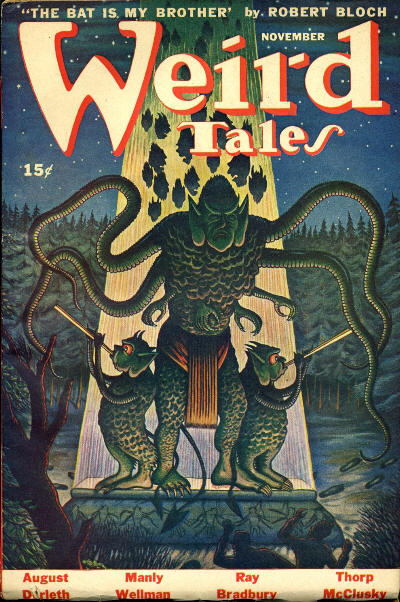A few posts back I mentioned how much I enjoyed the Sherlock Holmes stories of Ralph E. Vaughan. After reading both his Sherlock Holmes: The Cthulhu Mythos Tales and Sherlock Holmes: The Coils of Time and other stories, I purchased a used copy of Sherlock Holmes in the Dreaming Detective. I have included a quote from Ralph's post about the book and a link to his site below. The Dreaming Detective is set for the most part in Lovecraft's Dreamlands. The book itself is quite short, some 61 pages and that includes a second story, "The Adventure of the Laughing Moonbeast" which is also quite enjoyable.This post will include spoilers.
The Dreaming Detective begins in a New York City hotel room on January 2, 1943. Nikola Tesla is in bed close to death when he is visited by Albert Einstein. He has come to take Tesla to Washington D.C. to save Sherlock Holmes. Holmes is in a dream vault, a device designed by Tesla, which allows Holmes to remain in the Dreamlands without aging. Removing Holmes would mean that he would begin to age normally and given his advanced age, he would die. The machine monitoring Holmes indicates that he is in trouble and it has been decided that Tesla should travel to the Dreamlands to help Holmes. Tesla's relationship with Holmes is detailed in a series of flashbacks that occur on the journey. They first meet in Colorado Springs, Colorado in 1899. Tesla is there to conduct a series of experiments in wireless power transmission. The night of the experiment Telsa is approached by Holmes with a warning, one of his technicians, Heinrich Grantz is actually Wilhelm Reisen, an evil scientist whose experiments have killed killed scores of people. Holmes intends to arrest Reisen later, but during the experiment Reisen wounds Tesla and increases the power levels in an attempt to break down the barriers between our Earth and the Dreamlands. Homes intervenes, Reisen is propelled into the Dreamlands and a large severed tentacle is left behind. Giant tentacle, hurrah!!
Tesla and Holmes will meet again, Holmes explains that using a Heinsenberg pocket of uncertainty, Reisen was able to rescue Moriarty as he fell to his death. They have joined forces still hoping to break down the barriers between the two worlds. This would allow them to introduce magic into our world and gunpowder and internal combustion engines into the Dreamlands, conquering both worlds. Once in the still unfinished Pentagon, the site of the Dream Chamber, Tesla is brought up to speed. Reisen and Moriarty are in dream vaults in Berlin. The Dreamlands has been mapped by a number of Anglo-American expeditions and five agents have proceeded Tesla in attempts to rescue Holmes. Four have died and one is mad. Because of their friendship and because he has nothing to lose, he is dying anyway, Tesla uses the power of the dream chamber to project himself into the Dreamlands. During the course of his journey Tesla enters the Enchanted Wood of the Zoogs. Suddenly Tesla is captured by two Nazi stormtroopers, it seems Reisen has joined forces with Hitler. They have already killed a Zoog and intend to kill Tesla when, well the Zoogs's may or may not think it's okay to punch a Nazi, but they are quite happy to rip them apart and eat them. Tesla continues his journey to Dylath-Leen. Before he can locate Holmes he is captured by the strange creatures that serve the moonbeasts who of course make him drink wine, and yet more Nazi, who have replaced the moonbeast's flying galleries with airships pulled by frost worms. They then carry Telsa off to Plateau of Leng. I will leave it there.
Another great tale, despite it's length Vaughan has created a tapestry that mixes real and fictional characters from the Edwardian or Victorian period through the two world wars. He is faithful to Lovecraft's creation while expanding the parameters just enough to allow for a new and imaginative approach to the story of the Dreamlands which never seems formulamatic. Without going into lengthy expostulations Vaughan stitches together a rich and interesting backstory of both the continuing feud between Moriarty and Reisen and Holmes and the ongoing efforts of various governments to deal with the potential problems that the Dreamlands might present should the barriers weaken. It seems the Zoogs have already broken through at least once.
Most importantly it is a fun story, Tesla is a great addition to the Holmes canon and I always enjoy another well-realized trip to the Dreamlands.
"A few years ago I posted a blog about when I introduced Sherlock Holmes to HP Lovecraft in The Adventure of the Ancient Gods. If you're interested in reviewing it, you can click on the link in the title and be taken there. However, if you're interested in reading the story, you may have a bit of a problem. Copies of the original fanzine, Holmesian Federation #4 are very difficult to find and can be costly; copies of the chapbook published by Gary Lovisi's Gryphon Books are likewise hard to find and can be even more expensive, especially if it's the first edition with my name misspelled on the cover. Purchasing the book, along with any of my other Sherlock Holmes books published by Gryphon is no longer an option, thanks to a visit by Hurricane Sandy in 2012. That incident led me to republish a later book, which introduced Sherlock Holmes to HG Wells' Time Traveler as Sherlock Holmes: The Coils of Time & Other Stories. The "other stories" in the book were all new ones I had written after 2005, all either about Holmes directly, in homage to Holmes, or about other characters in the Canon.'
for the full post;
http://bookscribbles.blogspot.com/2015/08/sherlock-holmes-vs-cthulhu.html"
All illustrations by Earl Geier,
Gryphon Publications, 1992.











